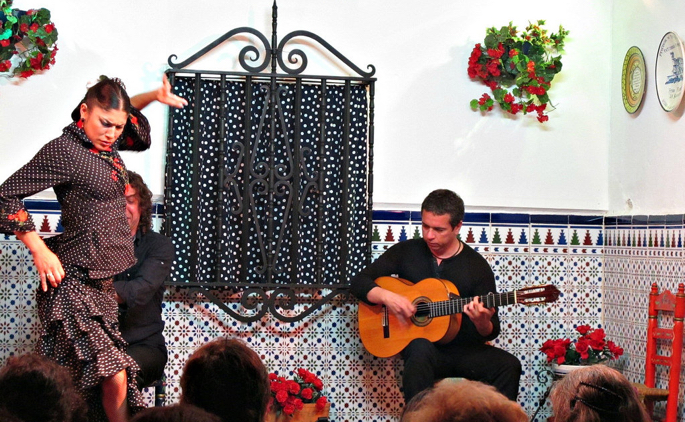Alegria is a cante chico flamenco form that belongs to the Cantiñas family and originates in Andalusian the town of Cadíz. It is usually played at a lively rhythm (120-170 beats per minute) and in a major key. Alegria letras focus on light-hearted themes like love, humor, and happiness – the word “alegria” literally means “joy.”
The compas of alegria is based on a twelve count similar to solea and emphasizes the 3, 6, 8, 10, and 12 beats:
1 2 3 4 5 6 7 8 9 10 11 12
Aleria is structurally one of the strictest forms of flamenco. A traditional dance in alegria must contain each of the following sections, in order:
- salida (entrance)
- paseo (walkaround)
- silencio (similar to an adagio in ballet – it is the singer who is “silent”)
- castellana (upbeat section)
- escobilla (literally “brush” as with a broom, which describes dancers’ footwork in this section)
- bulerias
This structure is often not strictly followed when alegria is played as a standalone song with no dancing. You will, however, frequently hear parts of this structure in solo guitar playing. In this way an artist can pay homage to the entirety of the art form, even when a dancer is not present.
Basic Alegria Rhythm
The basic alegria rhythm, played here by Curro Montoya of flamencoeduca.com in the key of C, demonstrates the basic feeling and spirit of alegria. This clip is a good example of a traditional style of basic compas. One might hear phrases like these played as a salida or as marking passages between coplas (verses).
Alegria Stylistic Variations
Individual guitarists, of course, put their own stamp on these basic themes and patterns. Here, for example, is Juan Cañizares playing an escobilla, then embellishing with picado runs and chord progressions reflecting his own style:
Juan Cañizares: Alegria
To hear more of Cañizares’s playing, as well as a full length alegria composition, check out the full article on his lecture demo at the University of Washington.
Pepe Habichuela: Variation on “Recordando Esencias”
One of my favorite solo alegria arrangements is Pepe Habicuela’s Recordando Esencias, from his Habichuela en Rama album. This clip, made available by El Dorado Sociedad Flamenca Barcelonesa, includes many of the themes and falsetas from that piece:
An excellent trascription of Recordando Esencias by Alan Faucher is available for purchase from Affedis.com
Accompanying Dancers
When played as dance accompaniment, alegria includes sections for letras, whether there is a singer accompanying the dancer or not, as well as specific passages devoted to footwork. Accompaniment and solo arrangements also often incude a silencio, a slow dramatic section in which the guitarist plays a traditional theme in a minor key.
To learn more about the individual parts of alegria dance accompaniment in detail and learn how to put them together in a full arrangement, check out the Alegria Accompaniment article which includes tab, a video demonstration, and a step-by-step explanation of alegria’s structure and flow.

